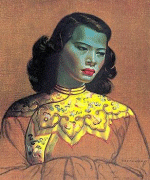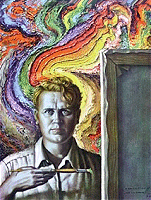'The
Chinese Girl' - Vladimir Tretchikoff
| The
most famous art print of all time is not the Mona Lisa - it is ‘The
Chinese Girl’ by Vladimir Tretchikoff. It can’t be called ‘enigmatic’
like the Mona Lisa, but has often been referred to as ‘kitsch’.
Due to the blue-green tone on the face the image is commonly known as 'The Green Lady'. Among the painting’s many fans is psychic Uri Geller, who comments: "How can anyone criticise art? You put a brick in the Tate today and it's art. Who decided that the Green Lady is kitsch? Not the hundreds of thousands who bought it." He was also to say, “I was very moved by the image. There is a subtle innocence in the face; there is some kind of spiritual ambience about that painting. It radiates an aura of peace of mind. The paintings are mesmerising. There is almost a hypnotic trance that captures the eye.” |
 |






